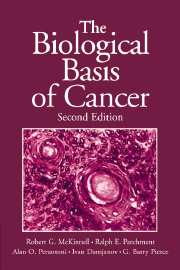Book contents
- Frontmatter
- Contents
- Preface
- Introduction: Letters illustrating clinical aspects of cancer
- 1 The pathology of cancer
- 2 Invasion and metastasis
- 3 Carcinogenesis
- 4 Genetics and heredity
- 5 Cancer-associated genes
- 6 Cancer in nonhuman organisms
- 7 Epidemiology
- 8 Lifestyle: Is there anything more important?
- 9 The stem cell basis of cancer treatment: concepts and clinical outcomes
- 10 Oncology: The difficult task of eradicating caricatures of normal tissue renewal in the human patient
- Appendix: Description of selected tumors
- Glossary
- References
- Index
- Plate section
3 - Carcinogenesis
Published online by Cambridge University Press: 05 June 2012
- Frontmatter
- Contents
- Preface
- Introduction: Letters illustrating clinical aspects of cancer
- 1 The pathology of cancer
- 2 Invasion and metastasis
- 3 Carcinogenesis
- 4 Genetics and heredity
- 5 Cancer-associated genes
- 6 Cancer in nonhuman organisms
- 7 Epidemiology
- 8 Lifestyle: Is there anything more important?
- 9 The stem cell basis of cancer treatment: concepts and clinical outcomes
- 10 Oncology: The difficult task of eradicating caricatures of normal tissue renewal in the human patient
- Appendix: Description of selected tumors
- Glossary
- References
- Index
- Plate section
Summary
For the first time in the history of the world, every human being is now subjected to contact with dangerous chemicals, from the moment of conception until death.
Rachel Carson, Silent Spring, 1962Introduction
Our environment has been described as a “sea of carcinogens” awash with a variety of chemicals and, to a lesser extent, with oncogenic viruses and high-energy radiations, all of which may contribute significantly to cancer incidence in humans. Although much of our attention has been focused on the proliferation of synthetic chemicals and their waste byproducts, an examination of these substances has revealed that, in fact, most chemicals are not carcinogenic. Testing by the U.S. National Toxicology Program (NTP), an agency within the Department of Health and Human Services charged with the responsibility of defining human carcinogens in the United States (Huff et al. 1988), and the International Agency for Research in Cancer (IARC), a part of the World Health Organization (WHO) with a similar but broader mission (Tomatis 1988), has shown that only one-fourth to one-third of those substances even suspected of being carcinogenic on the basis of their chemistries actually are cancer-causing agents. In fact, of the more than 80,000 chemicals listed for commercial use with the NTP, thus far only 228 have been categorized as being “known” or “reasonably anticipated” as human carcinogens according to the tenth Report on Carcinogens (released December, 2002).
- Type
- Chapter
- Information
- The Biological Basis of Cancer , pp. 80 - 125Publisher: Cambridge University PressPrint publication year: 2006



